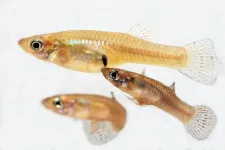(Press-News.org) Palo Alto, CA--Dehydrated plant seeds can lay dormant for long periods--over 1,000 years in some species--before the availability of water can trigger germination. This protects the embryonic plant inside from a variety of environmental stresses until conditions are favorable for growth and survival. However, the mechanism by which the baby plant senses water and reactivates cellular activity has remained a mystery until now.
New work jointly led by Carnegie's Yanniv Dorone and Sue Rhee and Stanford University's Steven Boeynaems and Aaron Gitler discovered a protein that plays a critical "go, or no-go" role in this process--halting germination if the soil's hydrological conditions are less than ideal or allowing it to proceed if the chances of survival are good. Their findings have major implications for understanding plant ecology in a warming world and for the possibility of designing drought-resistant crops that can survive climate change and fight world hunger.
Their work is published in Cell.
Dorone, Rhee, Boeynaems, Gitler, and their colleagues--including Carnegie's Benjamin Jin, Shannon Hateley, Flavia Bossi, Elena Lazarus, and Moises Exposito-Alonso--used molecular, physiological, and ecological research techniques to reveal a previously uncharacterized protein that they named FLOE1.
"Despite the extraordinary toughness of many seeds, plants are still at their most vulnerable during this stage of their lives, because germination must be precisely timed to ensure the greatest chance of survival. Once germination starts, the plant cannot go back into its hibernation state--the genie can't be put back in the bottle," Dorone explained. "So, a protein like FLOE1 is crucial to a plant's ability to walk the tightrope between too soon and too late."
The key to FLOE1's capabilities is a recently discovered biophysical phenomenon that's a hot research topic right now called phase separation. This mechanism allows cells to dynamically compartmentalize biomolecules into membrane-less assemblies, rather than cordoning them off in a cellular organelle surrounded by a membrane.
"Think of an organelle as an office building where components of the cell are assigned to complete their physiological jobs; whereas, these phase-separation-enabled assemblies are more like a maker faire or hackathon, where proteins can come together to accomplish a task and then disburse when it's complete," Rhee said. "We found that FLOE1's ability to very quickly initiate this type of temporary gathering is crucial to its functionality."
When a dormant seed senses moisture in its proximity, FLOE1 almost instantaneously assembles in the cell to test the waters, so to speak, and determine whether the conditions are good for the seed to reactivate and start growing. Because the FLOE1 aggregation is temporary and reversible, it can act as a go or no-go signal, halting germination if water availability is determined to be less than optimal, or allowing it to proceed if the environment has enough water to support successful growth.
"We believe that this is the first study that provides information on how seeds can directly perceive their hydration state and act upon it," Rhee added.
The authors say that their discovery could lay the groundwork for engineering crops that are able to harness FLOE1's abilities in order to withstand the detrimental effects of climate change. This type of enhancement will be increasingly important to combat hunger around the world.
Although their work was conducted using the experimental mustard green Arabidopsis thaliana, Dorone, Rhee, Boeynaems, and Gitler found found that FLOE1 is present throughout the plant kingdom, even in plants that precede the evolution of seeds, meaning it could play many additional roles in plant cellular physiology, which could have additional bioengineering potential.
"What's more, FLOE1 is the first known protein to reversibly phase separate over hydration-dehydration cycles, but it's likely that similar processes occur in other organisms that have desiccated periods of dormancy, including human pathogens," Dorone concluded.
INFORMATION:
Other collaborators on the research team were: Eduardo Flores and Shahar Sukenik of University of California Merced; Janice G. Pennington and Marisa S. Otegui of University of Wisconsin Madison; Emiel Michiels, Mathias De Decker, Katlijn Vints, and Pieter Baatsen of KU Leuven; George W. Bassel of University of Warwick; and Alex S. Holehouse of Washington University in St. Louis.
This work was funded by the U.S. Department of Energy, U.S. National Science Foundation, a Stanford Graduate Fellowship in Science and Engineering, the Carnegie Institution for Science, Brigitte Berthelemot, EMBO, and the U.S. National Institutes of Health.
The Carnegie Institution for Science (carnegiescience.edu) is a private, nonprofit organization headquartered in Washington, D.C., with three research divisions on both coasts. Since its founding in 1902, the Carnegie Institution has been a pioneering force in basic scientific research. Carnegie scientists are leaders in the life and environmental sciences, Earth and planetary science, and astronomy and astrophysics.
The principle that form follows function does not only apply to design and architecture. It also applies to biology. Every organism is a universe that lives thanks to the activities of tens of thousands of nanomachines, whose functions depend on their forms. Biologists say macromolecular complexes instead of nanomachines and structure instead of form, but the idea is the same: know the form and you will understand the function. Now, a group at the Spanish National Cancer Research Centre (CNIO) has helped determine the structure of a nanomachine essential for the functioning of another, mTOR, which plays fundamental roles in ...
A team led by researchers from Queen Mary University of London has developed a new artificial intelligence (AI) tool that is able to automatically measure the amount of fat around the heart from MRI scan images.
Using the new tool, the team was able to show that a larger amount of fat around the heart is associated with significantly greater odds of diabetes, independent of a person's age, sex, and body mass index.
The research is published in the journal Frontiers in Cardiovascular Medicine and is the result of funding from the CAP-AI programme, which is led by Barts Life Sciences, a research and innovation partnership between Queen Mary University of London and Barts Health NHS Trust.
The distribution of fat in the body can influence a person's ...
Many people instinctively associate mucus with something disgusting, but in fact, it has incredibly many valuable functions for our health. It keeps track of our important intestinal flora and feeds the bacteria. It covers all internal surfaces of our body, and, as a barrier to the outside world, it helps us protect ourselves from infectious diseases.
This is because mucus acts as a filter that keeps the bacteria in or out, and the bacteria feed on the sugars in the mucus between meals. So, if we can produce the mucus that is already present in the body with the right sugars, it might be used in brand new medical treatments.
Now, researchers from the DNRF Centre ...
Physicists of Ruhr-Universität Bochum (RUB) have taken spectacular pictures that allow the ignition process of plasma under water to be viewed and tracked in real time. Dr. Katharina Grosse has provided the first data sets with ultra-high temporal resolution, supporting a new hypothesis on the ignition of these plasmas: In the nanosecond range, there is not enough time to form a gas environment. Electrons generated by field effects lead to the propagation of the plasma. The nanosecond plasma ignites directly in the liquid, regardless of the polarity of the voltage. The report from the Collaborative Research Centre 1316 "Transient Atmospheric Pressure Plasmas: from Plasma to Liquids to Solids" has been published in the Journal of Applied Physics and Rubin, the ...
COLUMBUS, Ohio - Female vampire bats establish an egalitarian community within a roost rather than a society based on a clear hierarchy of dominance that is often seen in animal groups, a new study suggests.
Researchers observed more than 1,000 competitions for food among a colony of 33 adult female bats and juveniles living in captivity, assigning a rank to each bat based on a calculation of wins and losses in those contests.
The team found that, unlike in many mammal societies, the higher-ranking animal didn't necessarily win every bout over food, and there was a randomness to the ranking order - no specific quality they measured gave a bat a better chance at dominance, so any adult female had an equal opportunity to rank very high or very low on a scale of ...
Environmental education provision needs greater investment and innovation if future generations are to be able to respond fully to the climate emergency, experts have said.
The deepening environmental crisis will continue to worsen if there is not significant support and investment in environmental and science education, researchers have warned. Reforms would help young people to address the complex, interlinked and dynamic issues of our contemporary situation.
The experts argue Governments and other organisations must direct more funding to education innovation in response to consistent warnings from scientists about trends in the deteriorating state of ecosystems, biodiversity and climate, amongst other environmental issues.
Writing in Environmental Education ...
In mosquitofish, of the genus Gambusia, male fish are smaller than females - sometimes only half the size. Biologists had previously assumed that smaller male mosquitofish had at least some reproductive advantages. Researchers from the transregional collaborative research centre NC³ at Bielefeld University have shown in a systematic review and meta-analysis that larger mosquitofish are actually more successful at reproduction: they can, for instance, better challenge their rivals; they produce more sperm; and they are preferred by female fish. The re-searchers are presenting their findings today (07.07.2021) in the Journal of Animal Ecology.
Mosquitofish are small fish with nondescript coloring of the genus Gambusia, which contains some 45 species. ...
There are some large shield volcanoes in the world's oceans where the lava is usually not ejected from the crater in violent explosions, but flows slowly out of the ground from long fissures. In the recent eruption of the Sierra Negra volcano in the Galapagos Islands, which lie just under a thousand kilometres off South America in the Pacific Ocean, one of these fissures was fed through a curved pathway in June 2018. This 15 kilometre-long pathway, including the kink, was created by the interaction of three different forces in the subsurface, Timothy Davis and Eleonora Rivalta from the GFZ German ...
Driving through a tunnel is a challenging and risky task. Drivers need to lower their speed and adapt to poor light, while the enclosed space may make them anxious. Preventing accidents is a public health challenge that uses insights from engineering, psychology, physiology, and neuroscience. Here, in a virtual reality (VR) study in Frontiers in Psychology, scientists from China, Canada, and the USA show that playback of slow music inside tunnels can reduce tension and fatigue in drivers, making them less prone to speeding and overtaking. These results imply that well-chosen background music can help improve road safety.
"When drivers go through a tunnel, they need to process a large amount ...
How do predators know to avoid brightly-coloured toxic prey? A collaboration of researchers has put social information theory to the test in a reliable real-world system to find the answer - by copying what others do, or do not, eat.
An international team of researchers from Finland, New Zealand, Colombia and the U.K. have provided the first evidence that wild birds can learn to avoid distasteful prey by observing what others eat.
"We've known for a long time that predators, like birds, associate brightly coloured warning signals with the danger of eating certain prey types. However, ...

